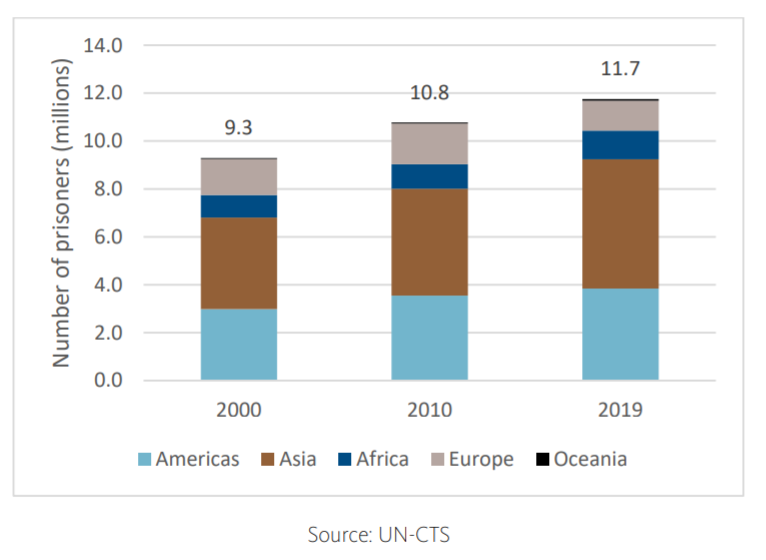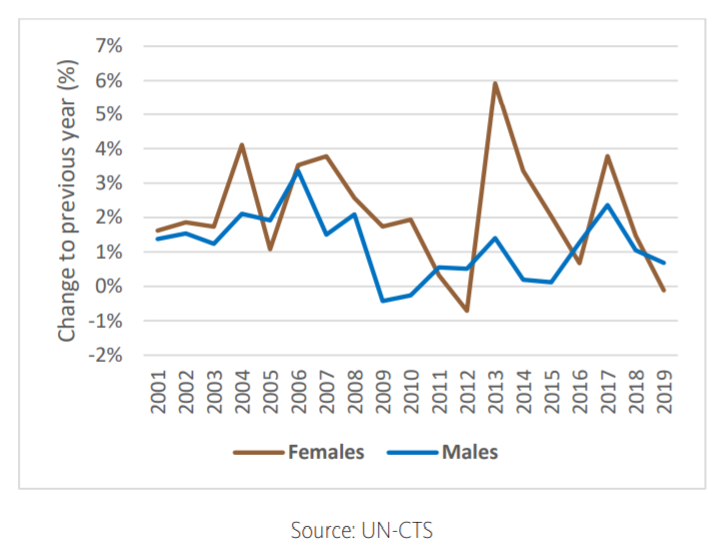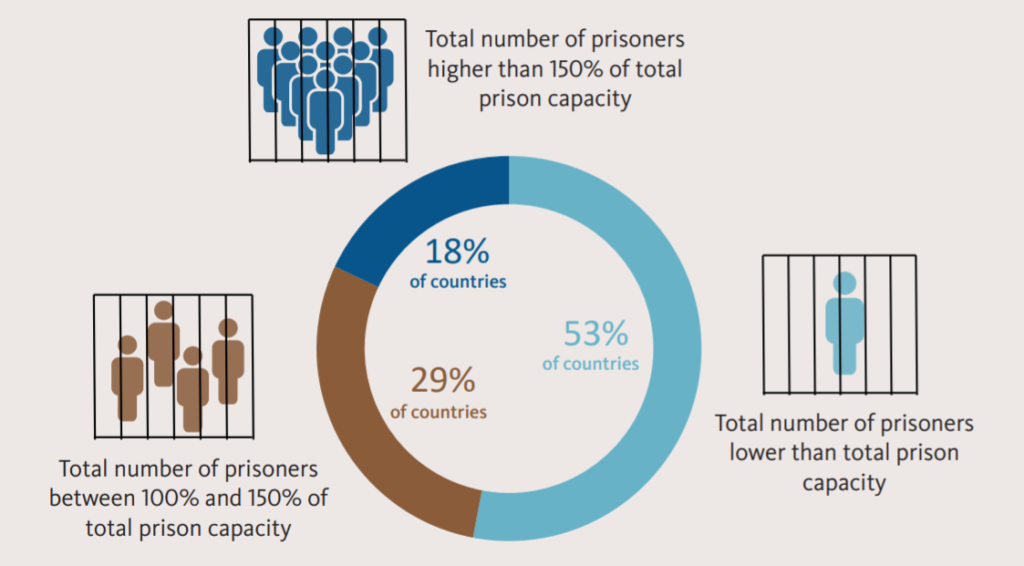Nearly 12M People Are In Prison Globally, And One-Third Of Them Are Unsentenced: UNODC
By a Biometrica staffer

The total number of people held in prison has increased by over 25% since 2000, with an estimated 11.7 million persons detained in jails across the world at the end of 2019. That number adds up to a population comparable in size to entire nations such as Bolivia, Burundi, Belgium, or Tunisia, according to a research report by the United Nations Office on Drugs and Crime (UNODC). In 2000, the total number of people in prison worldwide was estimated to be at around 9.3 million.
In today’s piece, we examine some of the key findings of the UNODC report, including the gender ratio of the global prison population, geographic differences, and the universal challenges of overcrowded prisons and unsentenced prisoners.
Gender Ratio
Of the 11.7 million people incarcerated at the end of 2019, estimates say 10.9 million were male while 0.8 million were female. A majority of the persons detained globally are men (at around 93%), but over the past 20 years, the number of women in prisons has increased at a faster pace than men (i.e., a 33% vs. 25% increase).
As a result, the female share of the global prison population rose to 7.2% in 2019 from 6.1% in 2000, with the largest increase being recorded in Europe. Meanwhile, over the past two decades, Africa has persistently recorded a low female prisoner ratio of around 2.9%.
Globally, there has been a 13X increase in the likelihood of more men being held in prison than women, but gender disparities are less marked in North America and Central Asia (where males are around 9 times more likely to be imprisoned than females), and much more marked in North Africa (45 times more likely) and South Asia (24 times more likely).

Geographic distribution
In terms of geographical regions, the Americas still have the highest ratio of prisoners to the wider population. North America is estimated to have had a ratio of 577 prisoners per 100,000 population, while the figure for Latin America and the Caribbean was at 267 at the end of 2019. Overall, the Americas had a ratio of 379 prisoners per 100,000 people in the general population.
That compares with an estimated 166 prisoners per 100,000 population in Europe, 158 in the Oceanic countries, 117 in Asia, and 92 in Africa. The global rate has not changed much over the past two decades and stood at an estimated 152 prisoners for every 100,000 population at the end of 2019.
Over time, some sub-regions have experienced a long-term decrease in the number of prisoners relative to their overall populations, such as North America, Sub-Saharan Africa, and Eastern Europe. Others like Latin America and Australia/New Zealand have been witnessing growth instead over the past two decades.
Overcrowding in prisons: a global challenge
Of the 100 countries and territories for which UNODC has data on both prison capacity and occupancy between 2014 and 2019, 47% were operating at more than 100% of intended capacity, the report says. A smaller share of countries and territories (around 18%) operate at an even higher 150%+ of intended capacity. On average, countries in Africa and the Americas have a high numbers of prisoners compared to their available space, but there are countries with insufficient capacities in every region of the world.
Prison overcrowding became an even more pronounced problem during the Covid-19 pandemic. As of May this year, it was estimated that nearly 550,000 prisoners in 122 countries had contracted Covid-19, with close to 4,000 fatalities in prisons across 47 nations, the report says, citing a global analysis of official and media sources. One in every five state and federal prisoners in the United States has tested positive for the coronavirus, a rate more than four times as high as the general population. In some states, more than half of all prisoners have been infected, the Associated Press, in collaboration with The Marshall Project, reported at the end of last year.
Some countries did opt to release, at least temporarily, large numbers of people in custody, particularly remand prisoners and those convicted of non-violent offences. Since March 2020, at least 700,000 persons around the globe (or 6% of the global prison population) were authorized for or considered eligible for release through emergency release mechanisms. Another fallout of the pandemic on the prison population across the world was the limiting of recreation, work opportunities, and visitation rights.
Those are all essential tenets of rehabilitation programs. Some of those impacts are still being felt, as many countries are dealing with a fresh spike in Covid-19 cases, particular of the delta variant. For instance, on Tuesday, July 27, it was reported that Louisiana’s eight state-run prisons had suspended prisoner visitation and volunteering in response to the state’s recent surge in cases. The suspension is scheduled to last for at least three weeks.

Unsentenced prisoners
One in every three prisoners worldwide is being held without having been found guilty by a court of justice, the report says. The global share of unsentenced detainees in the prison population has not changed much in the past 20 years, ranging between 29% and 31%. Asia and Africa had the highest share of unsentenced prisoners (both at 34%), while Europe had the lowest share (15%) as of 2019.
Even so, Africa has seen the sharpest decline in the share of prisoners who are unsentenced, which dropped from 45% in 2000 to 34% in 2019. In contrast, the Oceanic countries, including Australia and New Zealand, recorded a sharp increase over the same time period, from 20% in 2000 to 32% in 2019.